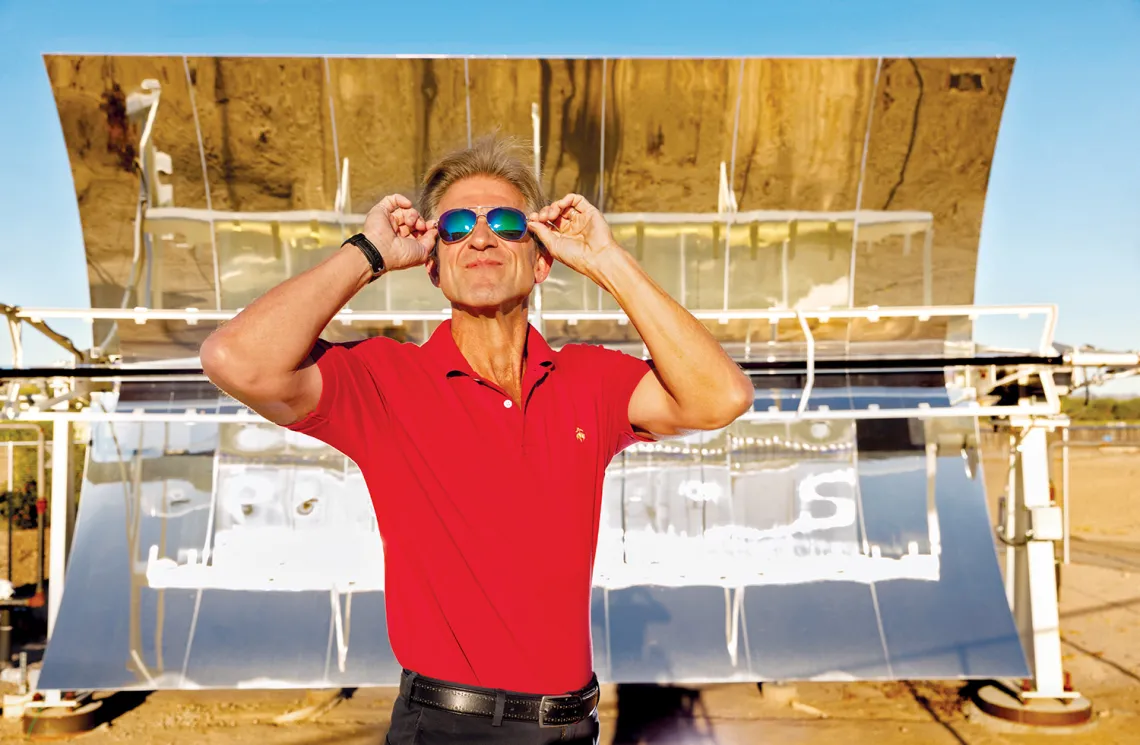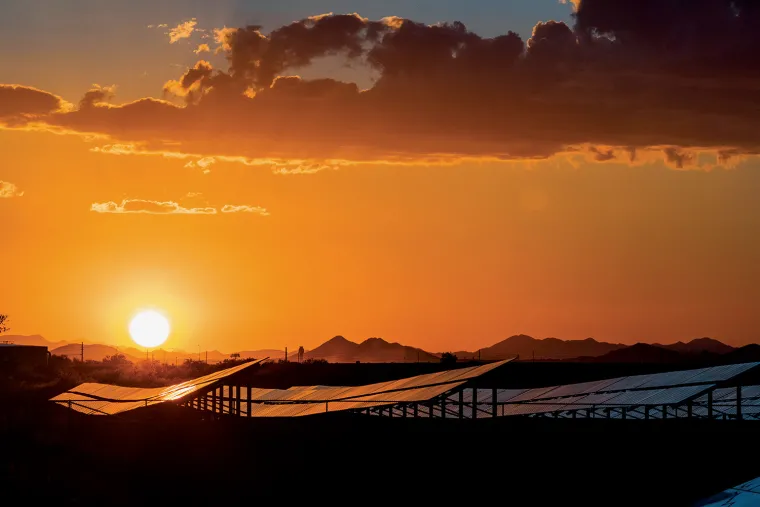Brightening the Future of Solar
Teamwork in the 'Fourth Industrial Revolution'

Optical sciences professor Robert A. Norwood in front of the FOCUS program’s prototype solar energy collector.
For better or worse, Arizonans know the sun. It’s no surprise here that its rays could deliver all the world’s energy needs.
University of Arizona experts are helping increase the use of solar energy through improvements in photovoltaic, or PV, technologies.
The effort is marked by increasingly complex cross-disciplinary work involving UA teams from engineering to chemistry to optical sciences.
The materials, devices and systems being developed cross all the old boundaries of science, illustrating what some, like UA President Robert C. Robbins, call a fourth industrial revolution, a synthesis of thinking akin to the revolutions in steam, automation and computers.
The stakes are high. As Kimberly Ogden, director of the UA’s new Institute of Energy Solutions, says, “We are working on integrating technology to ensure a stable global energy supply as the population increases — the ‘10 billion people problem.’”
The demand, too, is great. A typical large nuclear or coal-fired power plant produces a gigawatt of energy. The U.S. runs on roughly 20 to 25 terawatts (a terawatt is 1,000 gigawatts). Current solar capacity is about 40 gigawatts, or 0.04 terawatts; solar backers have a goal of 3 to 5 terawatts by 2030 — a steep challenge, but one that will make a significant difference in the nation’s reliance on fossil fuels. Some predict a U.S. PV market approaching 1 terawatt by 2021.
The UA has been a solar pacesetter for decades. As the solar market picks up momentum, UA research is tackling key issues to help spur the advance. Two areas of focus are improving PV panels and creating ways to store energy beyond batteries.

Solar panels at the UA Tech Park Solar Zone where researchers and more than 10 companies work together to test and evaluate solar technologies.

Solar panels at the UA Tech Park Solar Zone where researchers and more than 10 companies work together to test and evaluate solar technologies.
Testing the Hardware
In addition to driving new technologies, the UA is involved in assessing the strengths of existing ones.
Power companies need to know how resilient current PV systems are before they invest millions in arrays intended to last for decades. A UA laboratory near Fort Lowell Road and Swan Road addresses this question. The work, directed by Kelly Simmons-Potter at the Arizona Research Institute for Solar Energy, or AzRISE, has been underway for nearly a decade.
“We look at PV systems, like PV panels, batteries, inverters and electronics, to see how they hold up in a harsh climate like ours,” Simmons-Potter says.
The lab uses a degradation chamber to precisely control the environment. Conditions inside the test chamber mimic the worst features of an Arizona summer and winter as well as the large swings between Arizona days and nights.
“The work we are doing there is unique,” Simmons-Potter says. “We were one of the first ever to look at regional impact of climate on aging of materials.”
The team monitors the effects of ultraviolet exposure, heat, corrosion and rust on the systems. The damage is not visible to the eye, but it causes parts of a solar panel to fail and makes a system run at less than peak efficiency.
AzRISE works with Tucson Electric Power Company at a solar test yard on Irvington Road where they are studying how to create sturdier PV solar panels. Monitoring these PV devices can help utilities figure out what makes a design more resilient against aging and weather and plan their investments accordingly.
Solving the Day/Night Problem
A key limitation of solar energy is that it is only collected during daylight hours. Robert Norwood, at the UA College of Optical Sciences, is using a novel hybrid approach to saving daytime energy that could make solar more appealing to energy companies.
With a $4.4 million share of a $30 million project from the U.S. Department of Energy, Norwood has set up a prototype system at a College of Agriculture and Life Sciences site near West Miracle Mile that uses mirror-concentrated solar power and high-efficiency gallium arsenide-based photovoltaics.
A 25-foot-long parabolic mirror reflects and concentrates the sun’s light particles, called photons, toward a secondary mirror that sends the photons in the visible region of the light spectrum to a high-efficiency photovoltaic surface, producing energy directly. Meanwhile, the rest of the photons — those outside the visible spectrum, like infrared light — pass to a black tube filled with a high-boiling-point liquid, such as ethylene glycol (the key component in antifreeze), raising its temperature. The heat thus captured can be stored for use when the sun is no longer shining, either to heat a house or other space or to create steam to turn a turbine.
The work is part of a growing field of smart electric power research. Norwood’s approach is known as hybrid concentrated solar power/concentrated photovoltaic, or hybrid CSP/CPV.
“It changes the whole game by the double approach of capturing both electricity and heat,” Norwood says. “Since all the basic components for the system are available, when coupled with our proprietary designs the market entry of this system could be quite rapid for the right applications.”
Technologies seeking to surpass the silicon that has been used in PV to date need to be more efficient at capturing the energy of the sun’s rays, Norwood adds. While current panels run at 20 percent efficiency, Norwood’s team is trying to achieve 30 percent efficiency in research for the Department of Energy’s Micro-scale Optimized Solar-cell Arrays with Integrated Concentration, or MOSAIC.
New Ways to Store Solar Power
A parallel goal to finding ways to store solar power for use at night is reducing the amount of water used while generating electricity. The UA is developing solar collectors that could be the answer to both.
“Generating electricity without using water will be a paradigm breaker, a game-changing step,” says Dominic Gervasio, a researcher in the UA’s Department of Chemical and Environmental Engineering. Avoiding the use of scarce water supplies is far from trivial; electric power generation accounts for 2 percent of all water use in Arizona.
Gervasio’s approach uses a type of liquid chloride salt as an alternative to heavy petroleum for heat transfer. The liquid chloride salt allows the transfer of large amounts of heat, enough to energize carbon dioxide to turn turbines and produce electricity — similar to a conventional steam turbine, but without the water.
Transferring sunlight’s energy at high temperatures could make the UA research a key factor in the next generation of America’s electrical generation projects. Molten chloride salts can operate at temperatures over 750 degrees centigrade, a “magic number” for pushing a turbine with superheated carbon dioxide, rather than with steam, Gervasio says.
The hot chloride salt can also store heat from solar collectors more safely than other approaches. Gervasio collaborated with Peiwen Li’s Energy and Fuel Cell Laboratory in the UA’s Aerospace and Mechanical Engineering Department to make sure that the pipes carrying the heated liquids could handle the molten salts.
In the desert between Tucson and Yuma, these UA ideas are being put to work on a 3-square-mile plot along Interstate 8 near Gila Bend. There, a solar farm called Solana contains thousands of parabolic trough mirrors developed by Roger Angel, optical engineer and head of the UA’s Richard F. Caris Mirror Laboratory.
The mirrors concentrate sunlight onto black collector pipes and superheat the oil inside them, which can either heat water to make electricity in a steam turbine or heat molten nitrate salt to store the heat for nighttime power production. The Solana site makes 250 megawatts of electricity, enough power for more than 70,000 households.
For Grads, a Bright Job Outlook
UA students involved in all this solar research have strong job prospects after graduation. One in 50 new jobs in the U.S. is in the solar industry, and 1,000 new solar jobs are created every week.
Some Wildcat entrepreneurs have created their own jobs in solar. Kevin Koch ’93 helped start Technicians for Sustainability, a Tucson solar company with a staff of 50 today. It has outfitted 2,000 homes with solar.
Katharine Kent ’94 ’06 launched The Solar Store in 1998. “I wanted to solve problems and build things,” she says. So far, she has installed solar in about 6,000 homes and businesses. And Kent’s father, John Wesley Miller ’55, has built more than 90 solar homes in central Tucson.
“Arizona is the best solar state there is,” says Miller. “It’s affordable right now. Don’t wait.”
